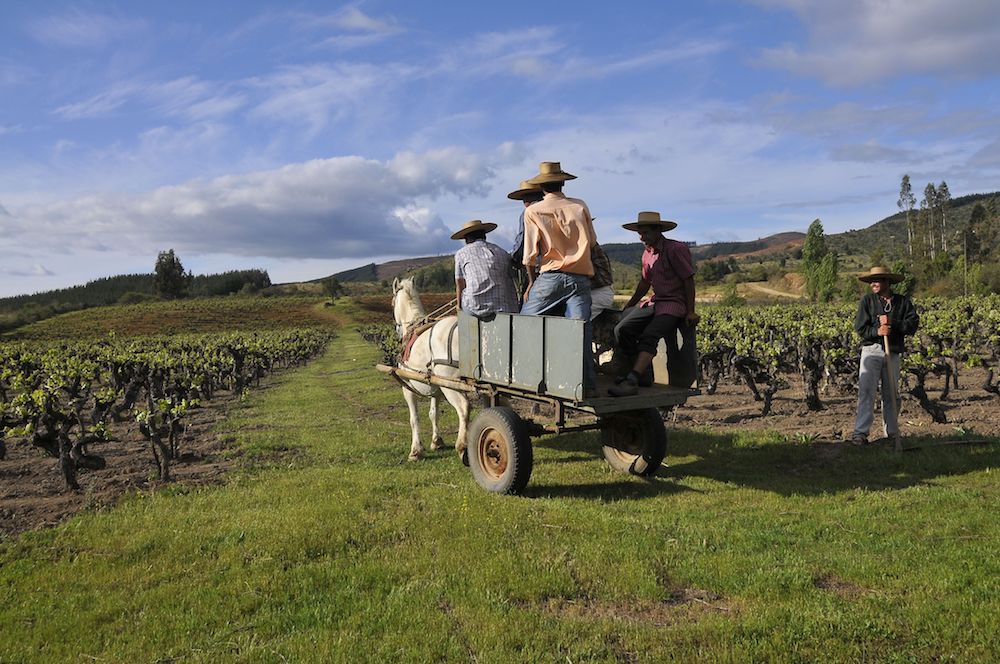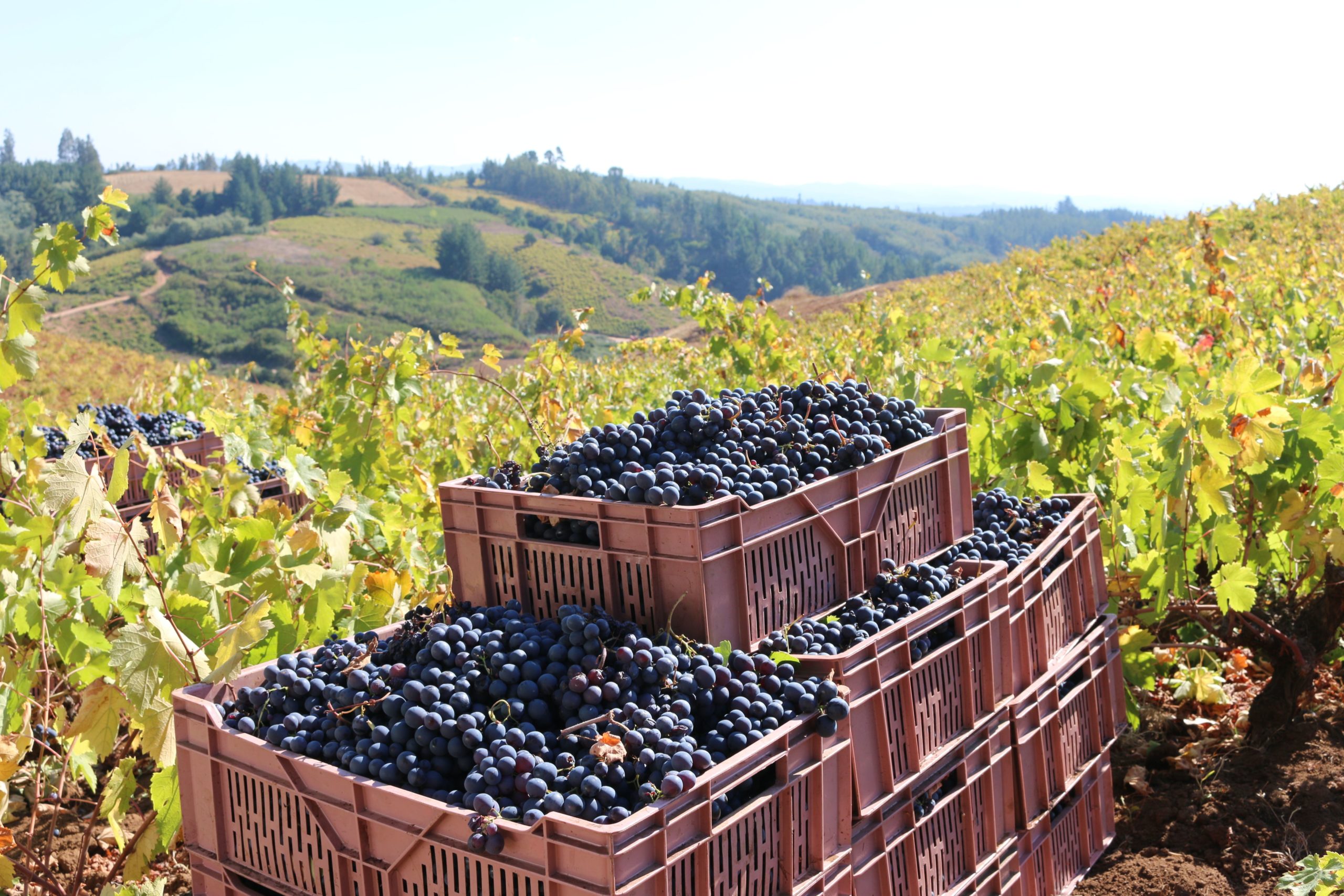Chilean chronicler and investigator Álvaro Tello shares his explorations of the arrival of Chile’s oldest grape varieties and his perspective on Chile’s winemaking identity — both old and new.
The concept of ‘identity’, an apparent moral and intellectual obligation to ask ourselves who we really are, has been a hot topic within the Chilean wine community in recent years. The phenomenon arguably started with Louis-Antoine Luyt — interestingly an outsider seeking the inner Chilean identity. Luyt was a bartender from France who more than a decade ago got to know the wines from Chile’s far south thanks to a fellow Frenchman, chef Yann Yvin. He didn’t just try these wines; he also wanted to make them. This was the origin of País de Quenehuao in 2009, the wine that wiped the dust off Chile’s oldest and most forgotten grape variety before the eyes of the local press.
A few years went by before Marcelo Retamal from De Martino once again jogged our memory with his Viejas Tinajas Cinsault 2011 from Itata, an area that had been converted by the Jesuits into Chile’s first large wine region in the 17th century. Retamal facilitated the rediscovery of a variety that arrived some time between 1930 and 1935 and that had for many years silently cohabited with the País, Moscatel and Torrontés vines that had been there almost five centuries.
And finally along came VIGNO, an association trying to bring back the Carignan grape variety which first came to Chile at some time between 1913 and 1924, and had been kept intact in the dry-farmed lands of Maule ever since.
Looking at these three different cases, we can identify a common factor. Irrespective of when they arrived in Chile, each of these grape varieties managed to survive thanks to the small-scale rural growers in southern Chile, unbeknownst to the big wineries who went in a different direction, seeking to satisfy the demands of the international markets.
From the very beginning, Chile has been enriched by foreign influences. This is undeniable. But this influence has taken two parallel paths.
In the middle of the 19th century, the first French agronomists came to Chile from the Gironde, Burgundy and Bordeaux, among other regions. They did not arrive empty-handed but brought their grape varieties with them. They came at the invitation of rich mining entrepreneurs, who saw France as a cultured role model. Chilean colonial manor houses were replaced by small stately homes in an effort to replicate French chateaux. On the recommendation of French naturalist Claudio Gay, the Quinta Normal was set up in 1841. French technicians began little by little to promote a scientific approach, producing wines from noble grape varieties with prestigious names on their labels.
Meanwhile Chile’s rural growers just continued to follow their instinct, and although they included some of these new European varieties in their vineyards, it was with the sole ambition of making the wine they needed to subsist and wanted to drink. In their rural vineyards, the Criolla varieties grew alongside the French ones.
At the beginning of the 20th century, while these two different social trends were occurring, more immigrants began to arrive. This time they were Italians, French-speaking Swiss, more French, Spanish Basques and Catalans. They contributed new ways of selling wine and some brought over new grape varieties, which they propagated discreetly, enriching Chile’s wine landscape.
The recent rediscovery of these old vines of País, Carignan and Cinsault is just the tip of the iceberg. As time has gone by, and thanks to the research carried out by winemakers like Juan José Ledesma of Terroir Sonoro, Hondarrabi Beltza was discovered on the banks of the rivers that cross the Bio Bio region. This grape variety, which is originally from the Basque Country in Spain, is thought to have been grown in Chile thanks to a family of Basque immigrants who came to southern Chile. They were probably trying to reproduce a wine known as Txakoli in northern Spain. Juan José had already been studying the area and discovered other varieties through ampelographic and genetic studies, estimating that many of them have been grown in Chile for between 80 and 100 years. These varieties include Palomino Blanco and Malbec, as well as Iona and Isabella. The North American hybrids were in fact introduced by French technicians who brought them to the country from France after the European phylloxera outbreak, in case phylloxera ever reached Chile.
Some growers, such as Víctor Castellón in Itata, have independently taken their grapes to be researched by the National Agricultural Investigation Institute (INIA). The DNA analysis has revealed that one of the grape varieties was Criolla Grande Sanjuanina; this finding led to this variety being registered for the first time in Chile. It was followed by a second discovery, and then a third: Folle Blanche and Plant de Chaudefonds, which were first recorded in Chilean literature in the late 18th century. Then came more samples, which were classified as “NN” (no name). In this way two new varieties or genotypes have been registered for the first time in the Chilean and international databases.
This information has been gradually confirming Juan José’s theory that in the area between Itata and Bio Bio, a great multicultural production centre has been forming for 500 years, influenced by the Spanish conquistadors, the Jesuits, French technicians and European immigrants. It is effectively an open-air laboratory showcasing Chile’s diverse varieties, when everyone assumed that the only grapes in the south were País, Cinsault, Torontel and Moscatel.
José Ignacio Maturana of Maturana Wines has increased my interest in researching old grape varieties, but in other regions, like Colchagua and Cauquenes. Torrontés, which was described by Jesuit Priest Alonso de Ovalle in 1646, can be found in small quantities in Colchagua. It is largely unknown by the industry. The only large-scale plantings of Torrontés are in Itata, where it is known as Torontel, and in the Marga Marga valley, where it is still confused with Moscatel de Frontignan. The few vines that remain in Colchagua are located in the middle of vineyards, on family pergolas or inside homes and are completely uncared for. What a shame.
Looking for this and other varieties, I went to Paredones in coastal Colchagua — a region that enjoyed a rich winemaking culture for more than a century, until it was impacted by the 1982 economic crisis in Chile. After a 30-year break, we believed that the return of grapevines to the area began thanks to Max Rodríguez and vineyards like Estampa and Casa Silva. But this story has an interesting twist.
Grape producer Max Rodríguez is the descendant of Doctor Eduardo Moore who went to Europe in 1891 to carry out medical study missions. When he came back, he had various grape varieties in his suitcases and these were planted on the family’s estate. The cuttings were soon shared among the farmers in the region. Thus viticulture in Paredones has a track record going back a century and a quarter and isn’t new at all, even though the producers’ associations keep insisting otherwise. Nor did it ever stop, because the owners of some neighbouring areas of land and the church of Paredones kept some of Dr. Moore’s varieties going, including Riesling, Moscatel de Alejandría, Semillon, other European and Criolla varieties, all planted by the doctor before 1900.
Last year José Ignacio Maturana made his first field blends with some of these historical grapes. In 2018, he made a wine from the San Francisco variety, a variety that used to be planted throughout Chile, from Huasco down to Itata. This variety was introduced between the period of the conquest and the arrival of the Jesuits, who in 1646 identified it as “Mollar”. It is actually two grape varieties, two crosses that at first glance appear to be quite similar and are therefore easy to confuse. DNA analysis has shown that the variety from Huasco is actually a cross between País and Moscatel, similar to Rosa del Perú, whilst the variety from Itata is a cross between San Francisco and Torrontés Mendocino. Both of them are South American Criolla varieties. Because the variety is interplanted with País and Cinsault in Itata, it has accidentally made its way into wine production but, for some strange reason, it has still not been institutionally recognised as appropriate for winemaking. Nevertheless, when José Ignacio came across the variety in Cauquenes he decided to make it into a wine, and called it Negra.
Interestingly, we have also seen this trend in medium and large wine companies, thanks to those winemakers who have the freedom to decide, experiment and go looking for old varieties and styles.
Casa Donoso in Maule is one winery that made an interesting discovery. When the French ampelographer Jean-Michel Boursiquot was in Chile, when he famously discovered Carmenère, he made another interesting discovery that is not so widely known. While visiting Casa Donoso’s La Oriental vineyard, he discovered some Romano or Cesar Noir vines. This Burgundian variety was brought by French technicians and planted in vineyards from Aconcagua down to Itata between the late 18th century and early 20th century. Romano disappeared suddenly from most Chilean vineyards some time between 1930 and 1940. Casa Donoso winemaker Felipe Ortiz decided to vinify grapes from the vines that had been growing on their land for 80 years, producing Sucesor Romano 2016.
Another contribution in historical terms was by winemaker Sebastián Labbé of Santa Rita, who discovered a field blend in Colchagua. This blend brings together the tradition inherited from the French technicians who arrived in the 19th century with the idiosyncratic techniques of Chilean agriculturists. Rather than blending their wines in vats or foudres, the French made their blends by directly calculating the production of different grape varieties in the vineyards. Chilean smallholders copied the idea but continued to add varieties that they considered more attractive, defying French taste. Labbé came across a vineyard that for just one wine had interplanted Sauvignon Vert, Corinto (Chasselas), Semillon, Torontel, Moscatel and one, probably Criolla, variety that is known by the farmers as Lamido de Perro, meaning ‘dog lick’. This white Floresta Field Blend from Apalta combines this rich history with the audacity that some Chilean vineyards have inherited.
The globalisation and internationalisation of Chilean wine have undoubtedly given it a new identity. But this is only one of several identities. Today many winemakers are looking to Chile’s oldest varieties, viticultural and winemaking techniques. These wines may be full of tensions and inconsistencies, but they certainly don’t lack imagination.

